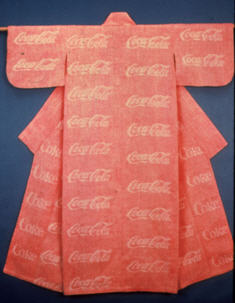Ever since her arrival in the Bay area in 1967, Yoshiko Wada has been a leading figure in all fiber arts. Her de Young exhibit piece, a 1975 “Coca-Cola” kimono, personifies the pop culture statements from that era. Andy Warhol had debuted his Campbell soup art in the early 70’s, so creating a satire of Asia opening to the western market was a logical and well-positioned statement by Wada.

"Coca-Cola Kimono" by Yoshiko Wada
The Coca-Cola kimono is a warp-predominant plain weave with ikat weft-resist dye. It utilizes the Japanese technique know as e-gasuri (sometimes referred to as “picture ikat”), where motifs are carefully chosen, and usually have a special meaning associated with the chosen symbol. As communicated by Yoshiko, “I made it as a conceptual piece and not as a kimono to wear in the same way ‘meisen’ kimono was worn.” The meisen style she references was an every day, comfortable garment that was in high demand post-World War I. In the de Young exhibit, a 1912-1940 Taisho Showa period ramie kimono, a warp and weft resist example, is displayed next to the Coca-Cola kimono. Juxtaposition of the two suggests a conversational posture – with old surpassed by new. The telling statement of the Coca-Cola kimono is still fresh and appropriate to our time. However, we can now see how today tradition overshadows brashness. Appreciation for the artful incorporation of meaning and tradition is once again forefront in our lives.
Yoshiko has not stood still as president of the Worldwide Shibori Network. She remains a constant inspiration for shibori artists around the world. In addition to teaching, lecturing and still creating her art, Yoshiko also promotes what is called the Slow Fiber Movement – a group that works to create culturally, socially and environmentally sustainable practices for fiber art. Slow Fiber credits the slow food movement for its inception. In many ways they are synchronous – both call to the need of honor and mindfulness in each step of creating what we eat and what we wear. It is a demonstration of how thoughtful intent is devoted to the making of things. It is not about consumption for the sake of creating, but, lending integrity to technique.
To find out more about Yoshiko Wada, visit her on her web page http://yoshikowada.com/ or on the World Shibori Network at http://shiboriorg.wordpress.com/ . For more information on the Slow Fiber Movement, visit the main site at http://slowfiber.wordpress.com/
For more on ‘thinking outside the box’ click here